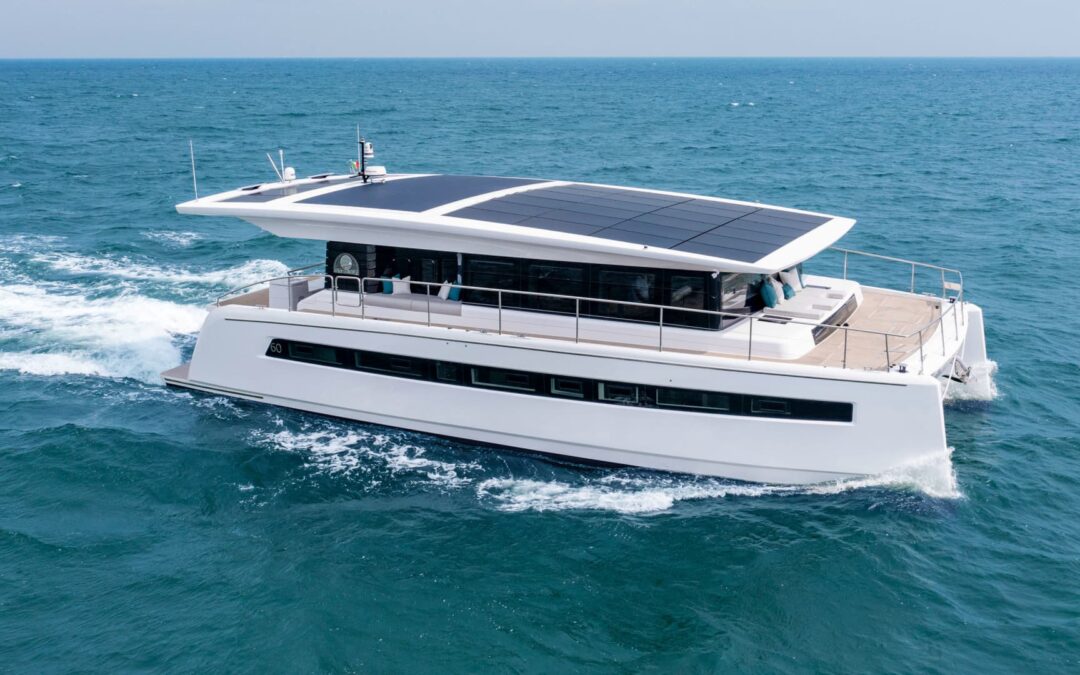Early tech adopters are investing in a new toy: solar-powered electric yachts.
Across the globe superyachts are already a must-have for today’s rich and famous. There are some 5,555 of them navigating the world’s oceans and seas, according to SuperYacht Times’ State of Yachting Report.
New buyers are overwhelmingly American, with the report finding that 30% come from North America.
While glamorous, the boating industry takes a huge toll on the environment, releasing carbon dioxide, nitrogen oxides and sulfur oxides into our air and waterways.
To mitigate the environmental impact, some vessels have started adopting electric power sources. In Sweden, ForSea Ferries converted two 364-foot ferries from diesel engines to battery-powered versions. However, each ferry has 640 batteries that weigh nearly 200 pounds each, significantly increasing the weight of the vessels.
In contrast, some companies have implemented solar-powered systems, which could potentially reduce that excessive weight. The market for solar-powered boats is projected by Allied Market Research to grow 14% by 2031 to $2.4 billion.
Mike Horn, a professional explorer and adventurer who has traveled to the North Pole on a trimaran sailing vessel, is a proponent of this type of modern shipbuilding.
“Electric yachts are the new generation of yachting,” he said. “I believe electric yachts and electric motors will be the main propulsion of pleasure yachts and even cargo vessels in the near future.”
Silent Yachts, based in Austria, and Poland’s Sunreef Yachts are two companies leading the development of this new technology.
Both companies use a similar technology, in which the solar panels harvest energy from the sun to recharge the battery. The lithium batteries also power onboard necessities like air conditioning and lighting. In the event that the sun isn’t strong enough, each vessel has a backup diesel generator that automatically recharges the battery.
“When we started building these yachts, many other boat builders told us there is no need for such a yacht,” said Silent Yachts CEO and co-founder Michael Köhler. “Everybody knows that it’s not a niche anymore. It is the new mass market.”
Silent Yachts builds yachts from the ground up and often refers to itself as the “Tesla of the seas.” Köhler, alongside his wife Heiki, founded the company in 2009. Since then, it’s delivered nearly 20 fully electric yachts and currently has over 30 in production in its shipyards in Italy and Turkey.
The company says it has an order book of 160 million euros ($168 million), with prices ranging from 3.2 million euros for its 60-foot yacht to 30 million euros for the fully equipped version of its 120-foot vessel.
“We have the next generation of solar panels coming to the market, the next generation of electric batteries coming to the market, and the next generation of electric motors,” said Stephan Kress, chief innovation officer at Silent Yachts. “The advantage, which is already there, of electric yachting will become bigger and bigger.”
Sunreef has been building yachts for over 20 years and its clients include celebrities like tennis star Rafael Nadal and Formula One driver Fernando Alonso. The company incorporates integrated solar panels into its yachts, which it calls a “unique” feature.
“The goal of the solar panel was to be able to integrate them into the whole structure of the boat,” said Nicola Lapp, Sunreef co-founder and chief technology officer. “The solar panel on our boat can be located anywhere, even on curved surfaces on the hull side.”
Sunreef has two shipyards in Gdansk, Poland, and a third in the Emirate of Ras Al Khaimah, where it says it has around 60 yachts in production. It does the majority of its production in-house, including making its own solar panels.
“The price range really depends on the customization of the yacht,” said Lapp. “The smallest boat is around 1.5 million euros and on the upper range there really is no limit. The most expensive boat that we have sold is around 60 million euros.”
To date, the company says it has built over 300 yachts, with 30 being fully electric, and half of current production is either electric or a hybrid eco model.
An important feature of the new technology, according to both Silent Yachts and Sunreef, is the relative simplicity of its day-to-day maintenance.
“They don’t have any moving parts,” said Kress. “The electric motors, they are maintenance free. The only things that you would need to maintain on the boat are heat exchangers and the backup generator, which is very limited.”
Nevertheless, the technology does pose challenges for companies looking to adopt it for large commercial vessels like cargo or cruise ships.
“We think there is a sweet spot for solar electric boats between 50 and 120 feet,” said Kress. “Once you make the boats a lot bigger, the advantage of solar diminishes because you have a limited amount of power.”
Horn, the explorer, added that electric yachts “do have their place” in the market.
“But that alternative energy sources, like hydrogen, would be able to allow our vessel to go further,” he said.







